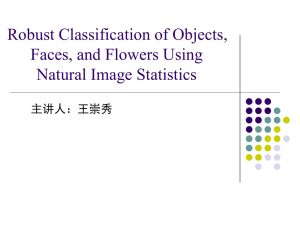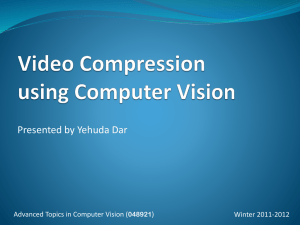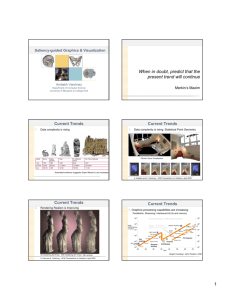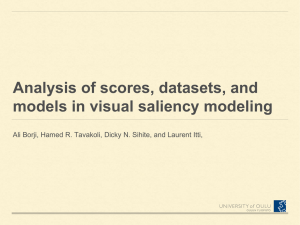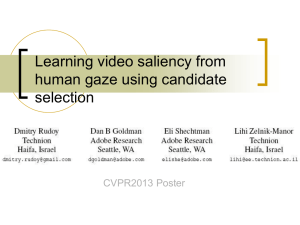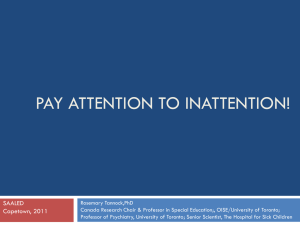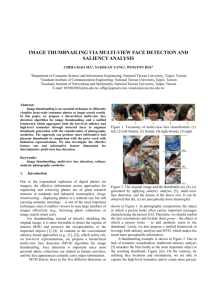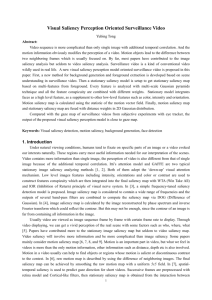This paper proposes a saliency stimulated object extraction (OE)
advertisement
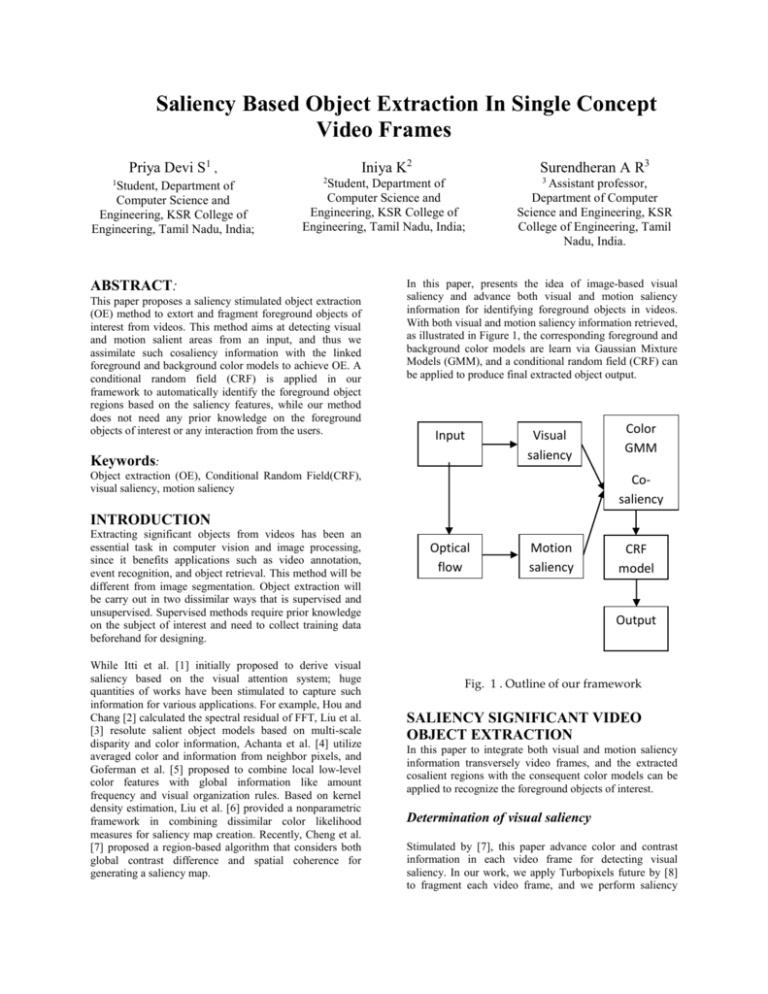
Saliency Based Object Extraction In Single Concept Video Frames Iniya K2 Priya Devi S1 , 1 Student, Department of Computer Science and Engineering, KSR College of Engineering, Tamil Nadu, India; Surendheran A R3 2 Student, Department of Computer Science and Engineering, KSR College of Engineering, Tamil Nadu, India; ABSTRACT: This paper proposes a saliency stimulated object extraction (OE) method to extort and fragment foreground objects of interest from videos. This method aims at detecting visual and motion salient areas from an input, and thus we assimilate such cosaliency information with the linked foreground and background color models to achieve OE. A conditional random field (CRF) is applied in our framework to automatically identify the foreground object regions based on the saliency features, while our method does not need any prior knowledge on the foreground objects of interest or any interaction from the users. 3 Assistant professor, Department of Computer Science and Engineering, KSR College of Engineering, Tamil Nadu, India. In this paper, presents the idea of image-based visual saliency and advance both visual and motion saliency information for identifying foreground objects in videos. With both visual and motion saliency information retrieved, as illustrated in Figure 1, the corresponding foreground and background color models are learn via Gaussian Mixture Models (GMM), and a conditional random field (CRF) can be applied to produce final extracted object output. Input Keywords: Visual saliency Object extraction (OE), Conditional Random Field(CRF), visual saliency, motion saliency Color Color GMM GMM Cosaliency INTRODUCTION Extracting significant objects from videos has been an essential task in computer vision and image processing, since it benefits applications such as video annotation, event recognition, and object retrieval. This method will be different from image segmentation. Object extraction will be carry out in two dissimilar ways that is supervised and unsupervised. Supervised methods require prior knowledge on the subject of interest and need to collect training data beforehand for designing. While Itti et al. [1] initially proposed to derive visual saliency based on the visual attention system; huge quantities of works have been stimulated to capture such information for various applications. For example, Hou and Chang [2] calculated the spectral residual of FFT, Liu et al. [3] resolute salient object models based on multi-scale disparity and color information, Achanta et al. [4] utilize averaged color and information from neighbor pixels, and Goferman et al. [5] proposed to combine local low-level color features with global information like amount frequency and visual organization rules. Based on kernel density estimation, Liu et al. [6] provided a nonparametric framework in combining dissimilar color likelihood measures for saliency map creation. Recently, Cheng et al. [7] proposed a region-based algorithm that considers both global contrast difference and spatial coherence for generating a saliency map. Optical flow Motion saliency CRF Cosalienc model y Output Fig. 1 . Outline of our framework SALIENCY SIGNIFICANT VIDEO OBJECT EXTRACTION In this paper to integrate both visual and motion saliency information transversely video frames, and the extracted cosalient regions with the consequent color models can be applied to recognize the foreground objects of interest. Determination of visual saliency Stimulated by [7], this paper advance color and contrast information in each video frame for detecting visual saliency. In our work, we apply Turbopixels future by [8] to fragment each video frame, and we perform saliency recognition at the superpixel. Compare to [7], this procedure results in edge-preserving superpixels with parallel size, and the use of these superpixels provide better visual saliency consequences. To determine the visual saliency of the extracted superpixels, we equivalently quantize every of their RGB color channels into 12 dissimilar bins, and further convert them into CIELAB color space due to its effectiveness in instead of color contrast information, as suggested by [4, 7]. First concern the saliency detection algorithm of [7], and evaluate the initial visual saliency of a superpixel rk as follows: (3) Once such motion in sequence is extracted, we establish the motion saliency across video frames to recognize the prospective foreground objects of significance. This is achieved by manipulative the saliency of the above optical flow using (1), and the concluding motion saliency map can be formed (one for each frame). (1) where Ds is the Euclidean distance among the centroid of rk and that of its neighboring superpixels r i, s control the width of space kernel, and (ri) is the mass of the neighbor superpixel ri, which is relative to the amount of pixels in ri. The last term Dr(rk,ri) measures the color variation among rk and ri (also in terms of Euclidean distance). Image segment which are nearer to the most salient region should be further visually significant than farther away ones. As a result, behind calculate the saliency score S(rk) for each patch rk, additional update the saliency S(i) for each pixel i by: (2) where S(i) is innovative saliency score resultant by (1) and dist(i) measures the Euclidian distance between the pixel I and its adjacent salient point. We note that distmax in (2) is a constant representing the maximum expanse from a pixel of interest to its nearest salient point within an image. As illustrated in Figure 2(b), our approach can smooth the resultant visual saliency and improve possible nearby salient regions. (a) (b) Determination ofvideo motion saliency Fig. 2. (a)Original frame. (b) visual saliency map In order to utilize the sequential characteristics of the input video, we detain the motion in sequence by scheming optical flow. To perform more precise optical flow assessment, we apply dense optical-flow with both forward and backward propagation [16] at every frame. Thus, each moving pixel i at frame t is determined by: (a) (b) Fig. 3. (a)Original video frame. (b) Motion saliency map Derivation of a cosaliency map for VOE Once both visual and motion saliency maps are resultant from an input video, we merge both in sequence and compute the connected cosaliency for later VOE purposes, as described in Figure1. It is importance noting that, when coiffure both saliency results, it is preferable to conserve the limit information since our vital goal is to fragment the objects of attention (not a region or a mask). Consequently, a edge-preserving term is introduced into our cosaliency determination: (4) In the above equation, A is the cosaliency map, ms and vs point out the sums of the motion and visual saliency values, correspondingly. We note that (4) leverages both saliency maps while the power for each is inversely proportional to the saliency values of the connected pixels. These improve the trouble of consequential in a biased cosaliency map if one of the saliency information is more dominant. As discussed above, the last exponential term on visual saliency is to preserve the visual boundary of the candidate foreground objects. Figure 4 shows several cosaliency detection examples using our proposed method, including comparisons with other state-of the- art image-based visual saliency detection approaches. Fig. 4. Cosaliency map this framework, the label Fi is calculated by the observation zi , while the spatial coherence between this output and neighboring remarks zj and labels Fj are concurrently taken into consideration. Therefore, predicting the label of an observation node is equivalent to exploit the following posterior probability function (6) Learning of Color Cues Across Video Frames While our cosaliency recognition process identify visual and motion salient regions in a video sequence, the saliency information itself is not sufficient for distinguishing foreground from background regions across videos. Therefore, based on the cosaliency detection results, we further consider saliency induced color information and construct both foreground and background color models for VOE purposes. To make the above color models, we obtain the cosaliency map of every video frame and consider the pixels contained by as saliency-induced foreground and those in the enduring parts as background. Similar to [7], we apply the Gaussian Mixture Model (GMM) with ten Gaussian components for everyone to model the connected CIELAB color circulation. For later feature fusion purposes, we use a single energy term EC to represent both foreground (ECF ) and background (ECB) color models, and EC is defined as: EC = ECF - ECB where ψi is the unary term which infers the likelihood of Fi with observation zi . ψi, j is the pair wise term relating the correlation among neighboring pixels zi and zj, and that among their predicted output labels Fi and Fj . Note that the observation z can be represented by a particular feature or a grouping of various types of features. To solve a CRF optimization problem, one can convert the above problem into an energy minimization task, and the object energy function E of (6) can be derived as (7) In our proposed framework, we define the shape energy function ES in terms of shape likelihood Xt S (derived by (5)) as one of the unary terms (5) In our proposed framework, we renew both color models for every frame, so with the purpose of these color models will be more adaptive to disparity of foreground or background diagonally video frames. It is also worth noting that, a prior VOE work in [5] only focused on modeling the foreground color information. (8) In addition to shape information, we need incorporate visual saliency and color cues into the introduced CRF framework. As discussed earlier, we derive foreground and background color models for object extraction, and thus the unary term EC describing color information is defined as follows: CONDITIONAL RANDOM FIELD (9) Note that the foreground and background color GMM models GC and GC b are utilized to originate the related energy terms ECF and ECB, which are calculated as Utilizing an undirected graph, conditional random field (CRF) [9] is an authoritative method to approximate the structural information of a set of variables with the related interpretation. For video foreground object segmentation, CRF has been toobject calculate the label of each Fig. applied 5. CRF for segmentation experimental pixel in an image I [5], [6]. As illustrated in Fig. 5, pixel i in a video frame is related with remark zi, while the unknown node Fi point out its related label. In As for the visual saliency cue at frame t, we convert the visual saliency score derived in (2) into the following energy term EV : (10) We note that in the above equations, parameters ws , wc, and wv are the weights for shape, color, and visual saliency cues, correspondingly. These weights organize the contributions of the related energy terms of the CRF model for performing VOE. It is also worth noting that, Liu and Gleicher [10] only considers the construction of foreground color models for VOE. As verified by [11], it can be concluded that the disregard of background color models would limit the performance of object extraction, since the only use of foreground color model might not be enough for characteristic between foreground and background regions. In the proposed object extraction framework, we now utilize multiple types of visual and motion salient features for object extraction. REFERENCES [1] L. Itti, Christof Koch, and Ernst Niebur, “A model of saliency-based visual attention for rapid scene analysis,” IEEE PAMI, 1998. [2] X. Hou and L. Zhang, “Saliency detection: A spectral residual approach,” in IEEE CVPR, 2007. [3] T. Liu et al., “Learning to detect a salient object,” in IEEE CVPR, 2007. [4] R. Achanta and S. Susstrunk, “Saliency Detection using Maximum Symmetric Surround,” in IEEE ICIP, 2010. [5] S. Goferman, L. Zelnik-Manor, and A. Tal, “Context-aware saliency detection,” in IEEE CVPR, 2010. [6] Z. Liu, Y. Xue, L. Shen, and Z. Zhang, “Nonparametric saliency detection using kernel density estimation,” in IEEE ICIP, 2010. [7] M.-M. Cheng, G.-X. Zhang, N. J. Mitra, X. Huang, and S.-M. Hu, “Global contrast based salient region detection,” in IEEE CVPR, 2011. [8] A. Levinshtein, A. Stere, K. N. Kutulakos, D. J. Fleet, and S. J. Dickinson, “Turbopixels: Fast superpixels using geometric flows,” IEEE PAMI, 2009. [9] D. Tsai, M. Flagg, and J. M. Rehg, “Motion coherent tracking with multi-label mrf optimization,” BMVC, 2010. [10] F. Liu and M. Gleicher, “Learning color and locality cues for moving object detection and segmentation.,” in IEEE CVPR, 2009. [11] K.-C. Lien and Y.-C. F. Wang, “Automatic object extraction in singleconcept videos,” in IEEE ICME, 2011.

